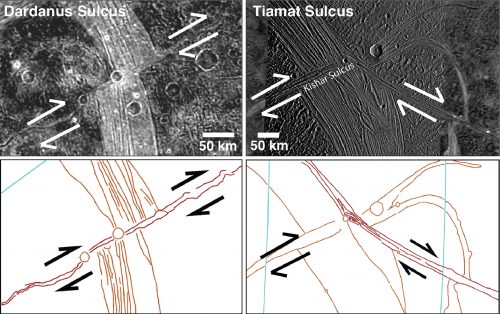A study of strike-slip indicators on Ganymede reveals striking findings
Do objects in outer space, which appear so enigmatic and extraterrestrial from our perspective, actually have geologic processes that resemble what we have on Earth? According to researchers from the University of Hawai’i, this appears to be true. Their studies on Ganymede, one of Jupiter’s moons, have revealed strike-slip tectonism that resembles tectonic plate activity along the San Andreas fault.
Marissa E. Cameron, PhD of the University of Hawai’i at Mānoa and her research team used satellite imaging to try and spot indicators of strike-slip tectonism, which refers to movements of tectonic plates that cause horizontal shifts of lands relative to one another.
Scientists think that Ganymede is an ocean world, which consists of an ice shell that contains liquid water inside of it. In order to study the effects of tectonism on the formation of Ganymede’s various morphologies, the researchers utilized Voyager and Galileo spacecraft imagery to extensively map nine sites on its surface. The sites covered grooved and light areas, which is indicative of younger terrain, as well as transition areas between this terrain and dark terrain, which is older land.
The researchers looked for four major indicators of strike-slip tectonism—possible strained craters, pre-existing features that are laterally offset, en echelon structure, and strike-slip duplexes. Strained craters refer to craters that have been tectonically deformed, and they can be analyzed as markers of natural strain. Pre-existing features that have undergone offset are signs of strike-slip faulting. En echelon structures refer to nearly parallel areas of land that are separated from one another by offsets. Finally, a strike-slip duplex refers to an area of land created by the bending of a strike-slip fault.
Cameron says that the most surprising finding of the study was how often the team found indicators of strike-slip tectonism. In fact, all nine studied locations exhibited at least one of these signs. En echelon features were discovered in all nine areas, and researchers found all four indicators of strike-slip tectonism in one of the nine locations, called Arbela Sulcus. The surprisingly high frequency of indicators is strong evidence that strike-slip tectonism plays a major role in shaping Ganymede’s surface morphologies.
Cameron points out that evidence collected by the Galileo and Voyager spacecrafts has shown that many of Ganymede’s morphological features are the result of extensional tectonics, which involves the stretching of land. “But this paper finds that strike-slip tectonics is prevalent enough that it needs to be considered alongside extension when examining how features on the surface form in a lot of places,” Cameron said.
The research team’s discovery—that strike-slip tectonics plays a noticeable role in Ganymede’s geologic processes—is relevant to future initiatives to further study Ganymede. Cameron mentioned the JUICE (Jupiter Icy Moons Explorer) spacecraft from the European Space Agency, which will launch in 2022 and gather data on Ganymede and two other moons, as one example of future studies this research will inform.
In addition, data gathered about Ganymede can give scientists an idea of what a younger moon orbiting Jupiter, called Europa, will become in the future. NASA wishes to launch the Europa Clipper in order to gather more data on Europa and study the possibility of sustaining life in its liquid water sublayer. Hence, research about strike-slip tectonics on Ganymede extends into other investigations regarding Jupiter’s moons.

